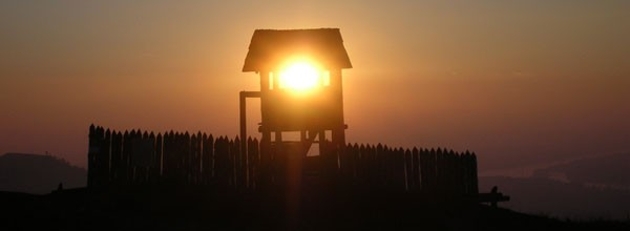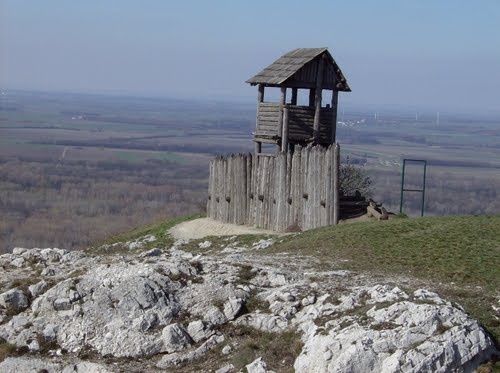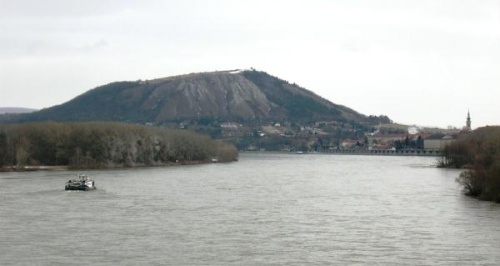Já si vždycky myslel, že Bójové vydržely tlak Germánů cca +/- do Ježíška a po Ježíškovi přežívali možná tak Kotinové zašití někde hluboko v horách, a tady se dozvím, že Bójové s budovatelskou písni na rtech rekonstruují hradiště ještě za zenitem říše římské. Díky za článek...
Celtic oppidum series, part four: the oppidum in Hainburg was rebuilt by archaeologists
Categories: Castles, strongholds and extinct places , Finds and rescue research abroad

In the next part of the series on Celtic oppids we will look at Austria, specifically Hainburg. Two thousand years ago, a fortified town stood on a local hill called Braunsberg.It was located at the so-called Uher Gate, which was the junction of the Amber and Danube routes, important for long-distance trade at the time. Along with the oppidum in Braunsberg, Devín, two kilometres away, and the oppidum on the Bratislava hill, which had a central function, also played an important role. The Austrian fortified town of Hainburg was inhabited by the famous Boii, who dominated the entire central Danube region. They minted the famous Biatec coins, which are still the symbol of the Slovak National Bank.

Archaeologists first started to excavate the site of the oppidum in 1931. The importance of the area is demonstrated by the rich mounds. The hillfort was destroyed in the first decades of AD; the Boii began to reconstruct it in the fourth century. That is, during the fall of the Roman Empire and the migration of peoples. They built a dry-laid stone mound near the oppida plateau. Archaeologists accurately described the fortifications in 1988. On the northern and eastern sides there was a three-metre high fortification without a palisade, and on the southern and western sides there was a wooden rampart 1.5 metres high.

During the excavation, archaeologists also discovered bunkers. They found shards with traces of graphite, which date back to the first century AD. The houses in the hillfort were underground with a hearth. Slovak archaeologists even made a model of the oppidum right in Hainburg on the site where it originally stood. It was opened to the public in June 2011. It is one of the most important archaeological reconstructions, and has been written about in many scientific publications. In the past, a model of the oppidum had already stood in Hainburg, but it was in poor technical condition. Archaeologists made a new one out of more durable materials. They even brought their own wood to Austria. The project was financed by the well-known Austrian foundation, the Sparkasse Stiftung, with thirty thousand euros donated to Heinburg on the occasion of its important historical anniversary. From the hill you can see the Danube and the Devín River as far as Slovakia and is therefore a popular tourist destination. Slovak archaeologists based their construction on the findings of their Austrian colleagues. Experts from the Faculty of Civil Engineering of the Slovak Technical University in Bratislava also worked on it. The palisade was 12.85 metres wide and 5.1 metres high. The hill itself is 346 metres high. However, the history of Braunsberg did not end after the Boii left, in the twelfth century there stood the castle of Röthelstein, which the Turks destroyed three hundred years later. This is proven by the surviving remains of the walls.
You can search for artefacts from this period with our metal detectors.
The article is included in categories:
- Archive of articles > Castles, strongholds and extinct places
- Archive of articles > Archaeology > Finds and rescue research abroad
Post
Bylo docela obtížné o tomto oppidu najít nějaké info, takže jsem překládala z němčiny, slovenštiny.. našla jsem, že : zničení hradiska nachádzame v neskoršom období opäť stopy po obnovení opevnenia v období cca 4. - 5 . storočia, tzn. v nepokojnom období pádu rímskej ríše a sťahovania národov. Vtedy pozdĺž náhornej plošiny hradiska na jeho okraji bol vybudovaný nasucho kladený kamenný val. A potom je tam, že všechny tři hradiště (Braunsberg, Devín, bratislavské hradní návrší...) před 2000 tisíci lety obývali Bójové.. jsem to špatně pochopila, sorry
Viky, to nic, stane se. Je tam toho ale víc: dřevěný val, palisáda široká 12,5 metru ... no nevím, nejspíš se cosi ztratilo v překladu. Ten odkaz na původní článek, zmíněný tocomabytem, nebo jiné zdroje, by tu dle mého názoru měl být uveden automaticky.
To samé platí i pro ostatní články. Bylo by vhodné uvést zdroj, popřípadě zdroje, ze kterých pisatel předkládané informace čerpal, a to nejen u textu, ale i u obrázků, pokud byly odněkud převzaty. AHA nebo BLESK, ty ať si své zdroje klidně nechávají pro sebe, beztak si ty nesmysly jejich „reportéři“ povětšinou cucají z prstu, ale webu s osvětově zaměřenými články, webu jako je www.lovecpokladu.cz, by informace tohoto typu nepochybně slušely.
tak na tu palisádu jsem hleděla, to si pamatuju. teď jsem našla i odkaz na článek, ze kterého jsem ani nečerpala a je to tam taky: Šírka palisády je 12,85 metra a maximálna výška 5,10 metra.
Čítajte viac: http://www.sme.sk/c/5967407/slovenski-archeologovia-postavili-v-hainburgu-keltske-opevnenie.html#ixzz2Q3nAMcrk
viz.
http://www.sme.sk/c/5967407/slovenski-archeologovia-postavili-v-hainburgu-keltske-opevnenie.html
Viky:
No vidíš, to je další důvod, proč se vyplatí uvádět zdroj: aby máslo nezůstalo na tvé hlavě. Jedná se ale o nepřesný popis, jsem o tom přesvědčen. Palisáda je opevnění z do země zapuštěných dřevěných prvků, převážně kůlů. Někdy bývá doplněna výztužnou konstrukcí, nicméně i kdyby byla tato započítána do šířky palisády, tak při výšce 5 m nebude široká 12. Palisáda bývá součástí komplexnějšího opevňovacího prvku (příkop, val, více palisád za sebou) a domnívám se, že v tomto případě se jedná právě o šířku celého opevňovacího prvku, nikoli palisády samotné. Co se týče onoho „dřevěného valu“, snad by to mohl být dřevo-zemní val, tedy val zpevněný nějakou formou dřevěné konstrukce. Umím si představit, že prověřování informací zabere spoustu času, ovšem pokud se přebírají z internetu, pak vzhledem k povaze tohoto média, tomu kde se chce vyhnout šíření nepřesností, asi nic jiného nezbývá.
Rakušané oppidia znovu pro poučení dalších generací staví, u nás se zasypávají, prý také pro budoucí generace...Mluvím zde konkrétně o Závisti na Zbraslavi. Pamatuji si oppidium zcela odkryté, pozůstatky byly fascinující svou rozlohou. Nevím kdo a proč nařídil místo zavézt zeminou. Teď tam není k vidění už nic. Škoda. 







